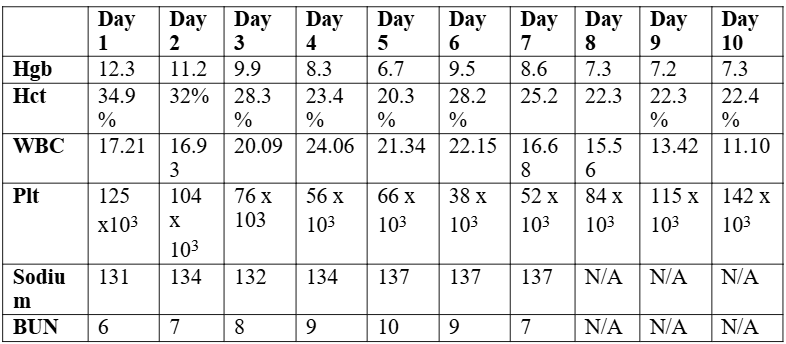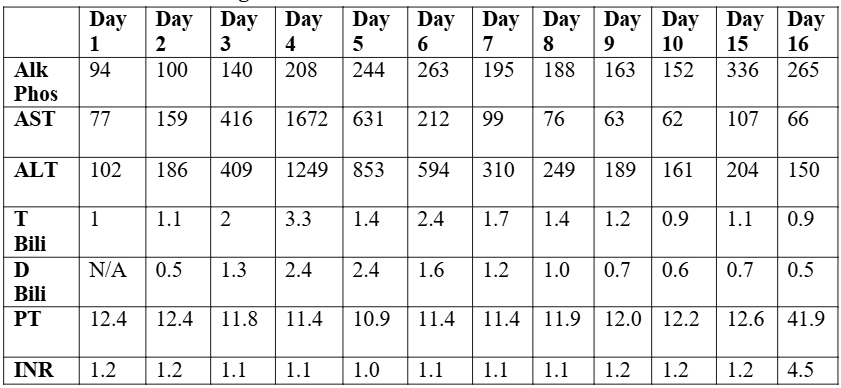Monday Poster Session
Category: Liver
P3951 - HELLP It’s Early
Monday, October 27, 2025
10:30 AM - 4:00 PM PDT
Location: Exhibit Hall
- MS
Momina Syed, BA (she/her/hers)
California University of Science and Medicine
Colton, CA
Presenting Author(s)
Momina Syed, BA1, Masuma Syed, MD2, Nasim McDermott, MD2
1California University of Science and Medicine, Colton, CA; 2Valley Hospital Medical Center, Las Vegas, NV
Introduction: HELLP syndrome is a rare diagnosis with an average occurrence of 0.27% of all pregnancies and recurrence rate up to 19% per patient. The syndrome involves hemolysis with microangiopathy, elevated liver enzymes, and a low platelet count. Usually, it does not present until the third trimester (28-40 weeks) of pregnancy, however it can occur during the late second trimester. This case report discusses a unique example of suspected early presenting HELLP syndrome in a patient with concerning past medical history.
Case Description/
Methods: We present a case of a 35-year-old 18-week pregnant G4P1A1 patient with a chief complaint of epigastric pain for 5 days with nausea, vomiting, and constipation. She had a history of early onset pre-eclampsia with severe features, and antiphospholipid syndrome (APS). Over the week, she presented to three hospitals and was discharged due to a benign workup. On her last visit, lab work showed elevated AST 77 U/L, ALT 102 U/L, total bilirubin of 1 mg/dL, and platelet count of 125 x103. Lab work from two days prior had unremarkable liver enzymes with normal platelets.
Infectious causes were ruled out. ANA, AMA, ASMA, bile acids, and ceruloplasmin were unremarkable. UA microscopic visualization showed RBC > 182/HPF. Ultrasound showed increased hepatic parenchymal echogenicity indicative of steatosis or liver disease. During workup, there was a concern for acute fatty liver of pregnancy, particularly in the setting of significant abdominal pain versus HELLP given initially slightly low platelets with elevated liver enzymes and an underlying history of preeclampsia and APS.
There was a continued upward trend for LFTs. Due to her worsening LFTs, thrombocytopenia, and ongoing discomfort, she was suspected of having HELLP Class 1 (severe) per the Mississippi Classification. After multidisciplinary discussion and extensive conversations with the patient and her family, on day 3 of admission, the patient and her family wished to proceed with a medical abortion. On day 5, the patient’s liver enzymes began to normalize.
Discussion: This case is an example of early-onset first trimester HELLP syndrome. Due to early presentation, HELLP syndrome was not higher on the differential diagnoses list until progression of lab abnormalities. There is an association between APS, early-onset preeclampsia, and negative maternal-fetal outcomes. For this reason, it is important to consider the development of early HELLP syndrome particularly in patients with a history of these conditions.

Figure: Trends in Laboratory Values

Figure: Trends in LFTs and Coagulation
Disclosures:
Momina Syed indicated no relevant financial relationships.
Masuma Syed indicated no relevant financial relationships.
Nasim McDermott indicated no relevant financial relationships.
Momina Syed, BA1, Masuma Syed, MD2, Nasim McDermott, MD2. P3951 - HELLP It’s Early, ACG 2025 Annual Scientific Meeting Abstracts. Phoenix, AZ: American College of Gastroenterology.
1California University of Science and Medicine, Colton, CA; 2Valley Hospital Medical Center, Las Vegas, NV
Introduction: HELLP syndrome is a rare diagnosis with an average occurrence of 0.27% of all pregnancies and recurrence rate up to 19% per patient. The syndrome involves hemolysis with microangiopathy, elevated liver enzymes, and a low platelet count. Usually, it does not present until the third trimester (28-40 weeks) of pregnancy, however it can occur during the late second trimester. This case report discusses a unique example of suspected early presenting HELLP syndrome in a patient with concerning past medical history.
Case Description/
Methods: We present a case of a 35-year-old 18-week pregnant G4P1A1 patient with a chief complaint of epigastric pain for 5 days with nausea, vomiting, and constipation. She had a history of early onset pre-eclampsia with severe features, and antiphospholipid syndrome (APS). Over the week, she presented to three hospitals and was discharged due to a benign workup. On her last visit, lab work showed elevated AST 77 U/L, ALT 102 U/L, total bilirubin of 1 mg/dL, and platelet count of 125 x103. Lab work from two days prior had unremarkable liver enzymes with normal platelets.
Infectious causes were ruled out. ANA, AMA, ASMA, bile acids, and ceruloplasmin were unremarkable. UA microscopic visualization showed RBC > 182/HPF. Ultrasound showed increased hepatic parenchymal echogenicity indicative of steatosis or liver disease. During workup, there was a concern for acute fatty liver of pregnancy, particularly in the setting of significant abdominal pain versus HELLP given initially slightly low platelets with elevated liver enzymes and an underlying history of preeclampsia and APS.
There was a continued upward trend for LFTs. Due to her worsening LFTs, thrombocytopenia, and ongoing discomfort, she was suspected of having HELLP Class 1 (severe) per the Mississippi Classification. After multidisciplinary discussion and extensive conversations with the patient and her family, on day 3 of admission, the patient and her family wished to proceed with a medical abortion. On day 5, the patient’s liver enzymes began to normalize.
Discussion: This case is an example of early-onset first trimester HELLP syndrome. Due to early presentation, HELLP syndrome was not higher on the differential diagnoses list until progression of lab abnormalities. There is an association between APS, early-onset preeclampsia, and negative maternal-fetal outcomes. For this reason, it is important to consider the development of early HELLP syndrome particularly in patients with a history of these conditions.

Figure: Trends in Laboratory Values

Figure: Trends in LFTs and Coagulation
Disclosures:
Momina Syed indicated no relevant financial relationships.
Masuma Syed indicated no relevant financial relationships.
Nasim McDermott indicated no relevant financial relationships.
Momina Syed, BA1, Masuma Syed, MD2, Nasim McDermott, MD2. P3951 - HELLP It’s Early, ACG 2025 Annual Scientific Meeting Abstracts. Phoenix, AZ: American College of Gastroenterology.
